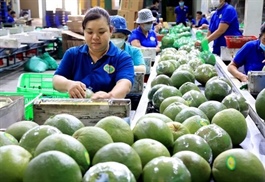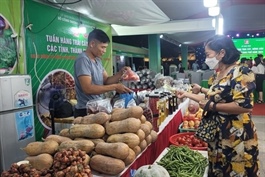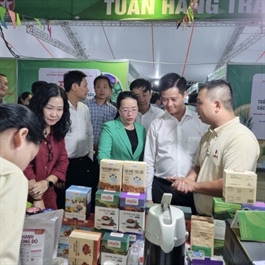The 20th Craft Village Fair 2024 begins
The 20th Craft Village Fair 2024 begins
The 20th Traditional Craft Village Fair has attracted nearly 100 units and businesses from 31 provinces and cities across the country, featuring 100 standard booths and over 1,000 square metres of specially designed exhibition space.

At the opening ceremony of the Craft Village Fair in Hà Nội City. — Photo hanoimoi.vn |
On October 3, the Agricultural Trade Promotion Centre held the opening ceremony for the 20th Traditional Craft Village Fair 2024, and presented awards for the Hanoi Traditional Craft Product Competition 2024.
Participating localities include Hà Nội, Bắc Giang, Thanh Hóa, Bà Rịa - Vũng Tàu, Phú Thọ, Đồng Nai, Đắk Nông, Tây Ninh, Tiền Giang, Nghệ An, Yên Bái, Bắc Ninh, Hà Nam, Quảng Ninh, Hải Dương, Lào Cai, Đắk Lắk, Thái Nguyên, Kiên Giang, Bến Tre, Lạng Sơn, Đồng Tháp, Khánh Hòa, Bình Thuận, Hòa Bình, Sơn La, Quảng Nam, Cao Bằng, Hải Phòng and Quảng Ngãi.
The fair showcases a wide range of handicraft products from traditional craft villages and streets, such as Bát Tràng ceramics, Mỹ Đức silk, Thường Tín embroidery, Canh Nậu wooden furniture, Xuân La toy figurines (tò he), and Phú Vinh bamboo and rattan products.
Additionally, the fair introduces numerous agricultural products that meet OCOP standards of three stars or higher, products with geographical indications, organic goods, and other standout items from various localities, including Sén Cù rice from Lào Cai, Đắk Lắk coffee, Thái Nguyên tea, Quy Hoa golden flower tea, and Chều village rice paper.
Within the framework of the fair, a forum titled "Promoting the Consumption of Traditional Craft Village and OCOP Products through E-commerce Platforms" will take place, aiming to exchange information and explore solutions for promoting and marketing craft village products and OCOP goods via e-commerce platforms.
A highlight of the fair is the live-streaming of craft village products and agricultural specialities on TikTok, aiming to diversify trade promotion methods, expand markets, increase customer reach and enhance economic benefits for localities.
The organisers have provided funding to support delegations of artisans, craftsmen, and agricultural officials from various regions to visit and learn at the fair. This initiative helps them connect with businesses, gain insights into the agricultural sector, explore value chain linkages, understand market demand, and learn about new trends in sustainable agricultural production.
At the opening ceremony, awards were presented to 61 winning entries in the 2024 Hanoi Traditional Craft Product Competition.
Speaking at the event, Nguyễn Minh Tiến, Director of the Agricultural Trade Promotion Centre, said that, according to the Vietnam Craft Village Association, the country currently has more than 5,400 craft villages. Of these, the northern region accounts for nearly 40 per cent, with around 1,500 villages concentrated in the Red River Delta, 300 of which have been recognised as traditional craft villages.
Tiến emphasised that craft villages are the custodians of handicrafts that embody the cultural essence of the nation, along with values related to landscapes, architecture, and heritage, offering great potential for developing Việt Nam's rural economy and tourism.
However, he also pointed out several challenges facing these villages, such as a lack of capital and production space, environmental pollution, small-scale production, slow product innovation, weak competitiveness, an unsustainable consumer market, and various risks.
Tiến hoped this fair would help enhance the image and competitiveness of handicraft products in both domestic and international markets.


























